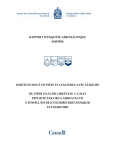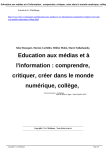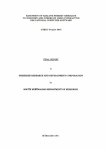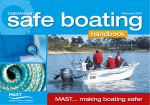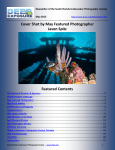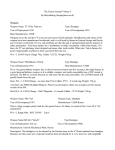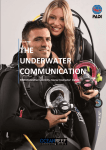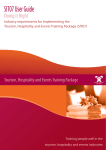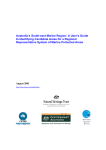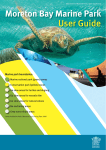Download Port Stephans - Great Lakes Marine Park Zoning Plan User Guide
Transcript
Introduction Port Stephens–Great Lakes Marine Park The Port Stephens–Great Lakes Marine Park (PSGLMP) was declared on 1 December 2005 under the Marine Parks Act 1997. It covers an area of approximately 98,000 hectares and includes offshore waters to the 3 nautical mile limit of state waters between Cape Hawke Surf Life Saving Club and Birubi Beach Surf Life Saving Club and all estuarine waters of Port Stephens and the Karuah River, the Myall River, Myall and Smiths Lakes and all of their creeks and tributaries to the limit of tidal influence. This multiple use Marine Park represents an opportunity to protect some of the state’s most spectacular and rich marine biodiversity while providing for sustainable use. The outstanding features of the Marine Park include: • Broughton Island, the second largest island in NSW, which provides important habitat for the threatened grey nurse shark and black cod; • Cabbage Tree Island (John Gould Nature Reserve), the primary breeding site for the threatened seabird Gould’s petrel; • The majority of islands, reefs, beaches and rocky intertidal areas in the bioregion, providing significant habitats for the diverse fauna and flora, with five areas identified as major habitat sites for the grey nurse shark; • Extensive and diverse estuaries and shorelines of Port Stephens and the Great Lakes regions including remarkable features such as the largest drowned river valley in NSW (Port Stephens), the largest brackish barrier lake system in NSW (Myall Lakes), and the largest intermittently open and closed lake in NSW (Smiths Lake); • The largest areas of mangrove and saltmarsh in the state, and 5 percent of the seagrass area in NSW; • Important socio-economic values including quality recreational fishing and productive commercial fishing grounds, aquaculture, many popular scuba diving sites, and regionally significant tourism activities such as whale and dolphin watching; • Many heritage listed sites, such as the spectacular lighthouses at Point Stephens and Seal Rocks; • A multitude of historic shipwrecks including the Satara, Oakland, Catterthun, and Macleay. Many significant Indigenous cultural and spiritual sites are located within or adjacent to the Marine Park including middens, burial sites and traditional campsites. Aboriginal association with the sea and land in the area dates back thousands of years, and many traditional practices are still undertaken today, including fishing and collecting. Zoning The PSGLMP Zoning Plan enhances conservation of marine habitats and species by providing various levels of protection whilst allowing for multiple use. The four types of zones that are applied in NSW marine parks are sanctuary zones, habitat protection zones, general use zones and special purpose zones. SANCTUARY ZONES provide the highest level of protection for habitats, animals and plants, ecological processes, natural features and areas of cultural significance by allowing only activities that do not harm plants, animals or habitats. Many recreational activities can be conducted in sanctuary zones including guided tours, boating, surfing, snorkelling, diving and permitted research and educational activities. HABITAT PROTECTION ZONES help to conserve marine biodiversity by protecting habitat and reducing high impact activities. A range of activities that are of social, commercial and economic importance to the area may continue in habitat protection zones, including recreational fishing, some forms of commercial fishing, tourist activities and fishing competitions. Habitat protection zones prohibit fish and prawn trawling and estuary mesh and estuary haul netting. GENERAL USE ZONES provide for a wide range of environmentally sustainable activities including both commercial and recreational fishing. General use zones complement other marine park zones and provide an integrated approach to the management and use of the Marine Park. General use zones allow for a variety of activities including trawling but excluding longlining, setlining and droplining. These zones are also found throughout the inlets, bays, estuaries, rivers, creeks and lakes in the Marine Park. SPECIAL PURPOSE ZONES provide for the specific management of aquaculture, fish-feeding, marinas and other vessel related facilities, commercial and residential facilities, fisheries and aquaculture research at a number of locations throughout the Marine Park. Permits A variety of activities undertaken in the Marine Park require permits from the Marine Parks Authority including: • Commercial activities • Collecting for commercial and private aquariums • Competitions including line fishing and spearfishing • Hovercrafts, airboats and seaplanes • Traditional Indigenous fishing use • Organised events including sporting or other activities • Research General Activities Guide Domestic animals Domestic animals are permitted within the Marine Park. However domestic animals are not permitted on, or in, waters that are reserved under the National Parks and Wildlife Act 1974 or beaches directly seaward of such reserves. The exception to this applies if they are assisting a disabled person, are a police dog, or if the owner has a Marine Parks Authority Permit, for such a purpose. Vehicles Vehicles are permitted on beaches of the Marine Park for the purpose of launching and retrieving vessels from designated boat launching facilities, or other beaches subject to Local Government and National Parks and Wildlife Service requirements. Fish cleaning Fish or fishing gear cannot be cleaned in a sanctuary zone. Trawl nets can be cleaned whilst transiting through a sanctuary zone provided the otter boards are out of the water and the cod-ends are open. Anchoring Anchoring is not permitted on seagrass beds in sanctuary zones. Vessel operators must ensure that no part of the anchor, chain, rope or vessel makes contact with a seagrass bed. Speed restrictions in sanctuary zones A 4 knot speed limit applies within the designated ‘speed restriction area’ of the Fly Point - Corrie Island sanctuary zone and the entirety of the Jimmys Beach sanctuary zone. These locations are recognised dolphin resting areas, particularly for females with calves. Taking of certain plants in habitat protection and general use zones For recreational purposes, it is permissible to hand collect sea lettuce (Ulva lactuca) and bait weed (Enteromorpha intestinalis) in habitat protection and general use zones. Seasonal closure - commercial The mouth of the Myall River at Bombah Broadwater is closed to commercial netting from the 1 May to 31 August each year. Habitat protection zone permitted fishing activities The fish species listed in Table A can be taken from habitat protection zones by the following fishing methods: • Line fishing • Hand gathering • Spearfishing • Scoop net, landing net, push net, scissor net, lift net Commercial submersible lift net (bait) and purse seine net are permitted only in the following locations within a habitat protection zone of the Marine Park: • Broughton Island - west of Cod Rock on the southern side and west of Flat Rock on the northern side and no more than 1 kilometre seaward of the mean high water mark • the Cabbage Tree Island habitat protection zone • within 500 metres of Tomaree Head • within 2 kilometres of Point Stephens at 32°44.900’S, 152°12.066’E Commercial prawn net (set pocket) is permitted only in the Smiths Lake habitat protection zone and the Myall River Camp habitat protection zone. Commercial haul netting is permitted only from the following beaches in habitat protection zones: • Boat Harbour Beach, One Mile Beach, Samurai Beach, Fingal Beach, Fingal Spit, Bennetts Beach, Mungo Beach, Boat Beach, Number One Beach, Shelly Beach, Elizabeth Beach, Seven Mile Beach and Lighthouse Beach (Sugarloaf Point). Little Beach restrictions The following restrictions apply in the Little Beach habitat protection zone: • no collecting • taking of fish by hand held line only • Land based line fishing is the only method of fishing permitted in the Little Beach Habitat Protection Zone. Fishing is only permitted from the wheelchair access jetty, the Little Beach Jetty and the beach between these jetties. Fishing from water craft is not permitted by any means in the area • berleying is not permitted. Diving restrictions in grey nurse shark critical habitats Dutchmans Beach restrictions No collecting is permitted in the Dutchmans Beach habitat protection zone. The following SCUBA diving activities are not permitted in declared grey nurse shark critical habitat areas: • night diving Broughton Island, Sawtooth and Edith Breakers restrictions • blocking an entrance to a cave or gutter containing a shark The following restrictions have been implemented to minimise potential impacts on key grey nurse shark aggregations: • feeding or touching a shark • NO FISHING FROM ANCHORED VESSELS: Fishing, spearfishing, lobster gathering or trapping is not permitted from vessels anchored in either the hatched Sawtooth or Broughton Island habitat protection zones. • wearing or using an electronic shark repelling device • FISHING WITH BAIT IS PROHIBITED: It is only permitted to take or attempt to take fish by way of artificial lure, artificial fly, fish trap, lobster trap, hand picking, spear or speargun in Broughton Island, Sawtooth or Edith Breakers habitat protection zone. • chasing or harassing a shark • using a powered scooter The following areas within the Marine Park are declared critical habitats for the grey nurse shark (as at January 2007): • The Pinnacle • Big Seal and Little Seal at Seal Rocks • Little Broughton Island Cabbage Tree Island restrictions Special purpose zones In the Cabbage Tree Island habitat protection zone fishing is not permitted except for yellowtail scad (Trachurus novaezelandiae), slimy mackerel (Scomber australasicus) and garfish (all species). Fish and/or plants can only be taken in a special purpose zone if a habitat protection zone or a general use zone adjoins the special purpose zone. The same provisions and restrictions apply to that of the adjoining habitat protection or general use zone. It is unlawful to be in possession of any fish other than the bait fish species mentioned above in the Cabbage Tree Island habitat protection zone (exemption exists for commercial fishers only). Setlining/droplining Setlining and droplining are not permitted in the Marine Park. Vessel lights can confuse and stress little penguins and Gould’s petrels returning to their nests on Cabbage Tree Island at night. For these reasons light restrictions have been implemented in the Cabbage Tree Island habitat protection zone: Seaplanes, hovercrafts and airboats • No lights can be switched on for longer than 5 minutes in any 60 minute period, except for: Motorised water-sports – a light required to be used under the Navigation Act 1901 or the Marine Safety Act 1998, or – a bait collection light suspended less than 5m high and which projects a spread of light downwards that is less than 20 metres at its widest point. Open Ocean restricted habitat protection zone restrictions The following restrictions apply in the Open Ocean restricted habitat protection zone: • Taking of fish by recreational trolling only permitted between 1 December and 30 April (inclusive) each year. • No other fishing methods permitted. • No fishing from anchored or drifting vessels. A permit is required from the Marine Parks Authority to operate a seaplane, hovercraft or airboat on the waters of the Marine Park. Motorised water-sports are not permitted in sanctuary zones, except for Smiths Lake and Boolambayte Lake sanctuary zones, or, via a Marine Park permit, in the Fly Point - Corrie Island sanctuary zone. Motorised water-sport means the following: (a) irregular driving (b) towing a water skier or aquaplaner with a motorised vessel Personal Water Craft (including jetskis) are not permitted within 200 metres of the shore in the Dutchmans Beach habitat protection zone. Vessels travelling through sanctuary zones All vessels may transit through a sanctuary zone. • Bait use is permitted whilst trolling. Vessels must stow any fishing gear whilst transiting a sanctuary zone. • All fishing is prohibited within this zone between 1 May and 30 November (inclusive) each year. Vessels anchored, moored or aground in sanctuary zones must have all fishing lines unrigged. Trawlers must have the cod end of a trawl net open and the otter boards out of the water whilst transiting a sanctuary zone. Commercial operations All commercial operations require a permit from the Marine Parks Authority. Competitions, organised sports and other organised activities All competitions, organised sports or other organised activities require a permit from the Marine Parks Authority. NOTE: The Fisheries Management Act 1994 continues to apply in the Marine Park including fishing closures, size and bag limits and grey nurse shark critical habitat regulations. Table A: Habitat protection zone permissible fish species Common Name Class/Family Species Finfish Class Osteichthyes All species Shark, ray Class Chondrichthyes All species Lobster, crayfish Family Palinuridae All species Slipper lobster Family Scyllaridae All species Prawn Family Penaeidae All species Squid Family Sepiidae All species Cuttlefish Family Spirulidae, Sepiidae and Sepiadariidae All species Beach worm Family Onuphidae All species Ghost shrimp, marine yabby (nipper) Family Callianassidae All species Mud crab Family Portunidae Scyalla serrata Blue swimmer crab Family Portunidae Portunus pelagicus Rock crab Family Grapsidae All species Oyster Family Ostreidae Saccostrea spp. and Crassostrea spp. Akoya pearl oyster Family Pteriidae All species Pipi Family Donacidae All species Cockle Family Orcidae All species Clam Family Veneridae All species Mussel Family Mytilidae All species Scallop Family Pectinidae All species Sea urchin Family Strongylocentrotidae All species Cunjevoi Family Pyuridae All species Turban shell Family Turbinadae Turbo spp. Abalone Family Haliotidae Haliotis rubra Periwinkle Family Trochidae Austrocochlea spp. NOTE: Except as otherwise protected under the Fisheries Management Act 1994. Zone Markers Zone markers indicate zone boundaries within the Marine Park and come in a variety of shapes and sizes as required to suit a specific site. Examples of these markers are provided below. It is an offence to moor a vessel to, or otherwise interfere with, a zone marker. Infringement and Incident Reporting Port Stephens-Great Lakes Marine Park Locked Bag 800, Nelson Bay NSW 2315 Ph: (02) 4984 8270 Fax: (02) 4984 8271 email: [email protected] Web: www.mpa.nsw.gov.au Pollution Office of Environment and Heritage Environment Hotline 131 555 Web: www.environment.nsw.gov.au Fisheries NSW Department of Industry and Inves tment Fisheries Information Line 1300 550 474 24 Hour Watch Line 1800 043 536 Web: www.dpi.nsw.gov.au/fisheries Disclaimer Boating NSW Maritime Licences and Testing, Registrations, Moorings, Weather Forecasts, Commercial Vessels certification information. Ph: 131 236 Web: www.maritime.nsw.gov.au Marine Mammal, Reptile and other Wildlife Office of Environment and Heritage Ph: 1300 361 967 Web: www.nationalparks.nsw.gov.au Please be warned that $500 on the spot fines and heavy penalties of up to $110,000 apply for infringements against the zoning plan and breaches of the Marine Parks Act 1997, the Marine Parks Regulation 2009 and the Marine Parks (Zoning Plans) Regulation 1999. There are also the provisions for the confiscation of fish, fishing gear, boats, trailers, vehicles and other equipment. This brochure provides a plain English guide to the zoning for the Port Stephens - Great Lakes Marine Park. Full details of the zoning plan are contained in the Marine Parks (Zoning Plans) Regulation 1999 via the website www.legislation.nsw.gov.au. this brochure should not be used for navigation or legal interpretation purposes. No warranty is given that this User Guide is free from error or omission. This User Guide should not be used as an aid in determining whether an activity is safe to perform. Users of this guide should satisfy themselves of the accuracy of the information contained herein through their own enquiries. The NSW Marine Parks Authority and its servants and agents expressly disclaim liability for any act done, or omission made, based on the information in this User Guide and any consequences of any such act or omission. The information contained in this User Guide may be subject to change. PHOTOGRAPHY: Little Penguin - G Robertson DEC ©; Gould’s Petrel - DEC ©; Fisher - DEC ©; Humpback Whale - Simon Allen ©; Underwater Photos - David Harasti © All other photos supplied by MPA © PSGLMP 03/13








